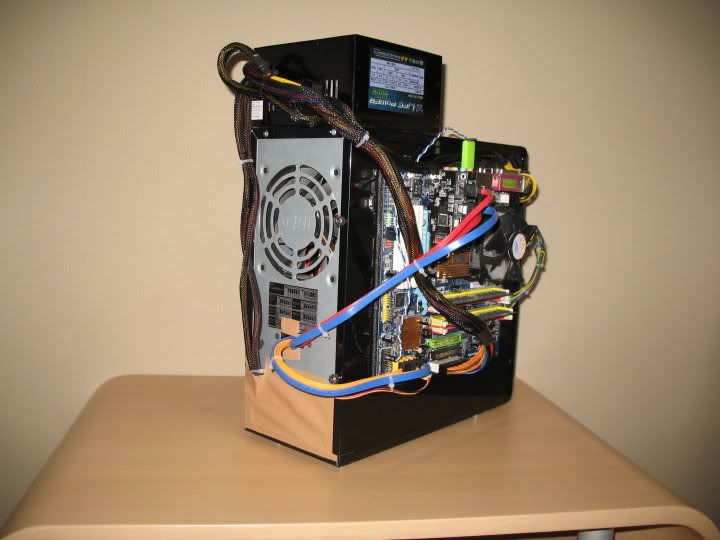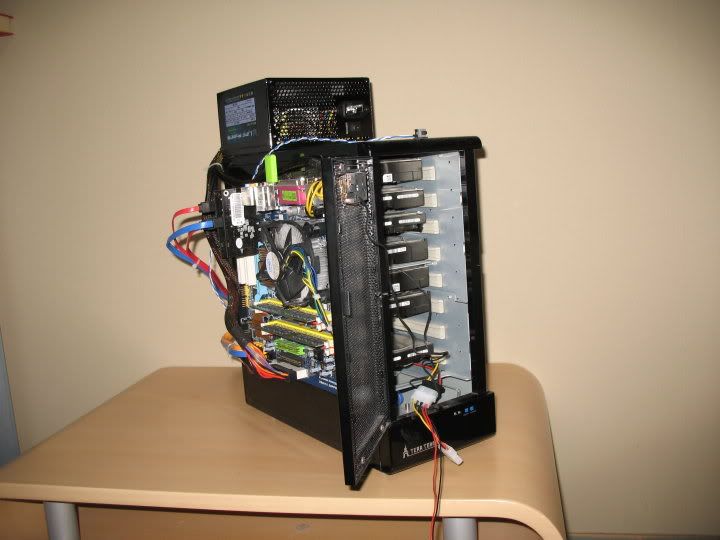
ReneV
-
Posts
133 -
Joined
-
Last visited
Content Type
Profiles
Forums
Downloads
Store
Gallery
Bug Reports
Documentation
Landing
Posts posted by ReneV
-
-
-
You mean you're not sold already?

Fair enough. I am, actually
 But, I can't just buy everything I'm sold on. There has to be a longer-term expectation of use ...
But, I can't just buy everything I'm sold on. There has to be a longer-term expectation of use ... -
I'm sure that could be a possibility!
With WOL I'll be sold.
-
WOL support for sleeping servers?
-
In case it needs saying, I'm keeping a keen eye on this thread and will revisit the latest version of the sleep script as soon as something looks actionable.
Personally, I have no problem with the functionality that's being discussed.
NB! If I remember correctly, I changed the script file from Windows to *nix format. (It was probably a mistake to not convert it back to Windows format before uploading it; sorry.) If you have issues, try looking at line-termination issues in your local copy of the script.
-
Thanks for the comments. My wife, in particular, seems to enjoy them
 Personally, I'm conflicted whether something that sits straight and flush, and uses zip ties can be called untidy ... ah, who am I kidding, I've been grinning non-stop since the comments started coming!
Personally, I'm conflicted whether something that sits straight and flush, and uses zip ties can be called untidy ... ah, who am I kidding, I've been grinning non-stop since the comments started coming!As for insulation, yes, I probably need to get proper risers in there.
-
I give you "albert", from unstein = un[RAID] + [Franken]stein.
The case is a TeraTower, formerly an external USB enclosure. I bought it just before I started with unRAID but it didn't work as intended for me, and I've been annoyed for years that I spent money on it when I knew I should have gone for a stand-alone solution straight away. Recently, the kids and I needed a DIY project for a long weekend
 . I had various computer parts lying around and a bit of a space issue on my primary unRAID server and we ended up with the first version of this after a day or so of handling and choosing components, and some somewhat drawn-out problem solving
. I had various computer parts lying around and a bit of a space issue on my primary unRAID server and we ended up with the first version of this after a day or so of handling and choosing components, and some somewhat drawn-out problem solving  . I've since replaced the power supply with the one in the picture and done various other adjustments, in part to prolong the experience with the kids. The basic specs are
. I've since replaced the power supply with the one in the picture and done various other adjustments, in part to prolong the experience with the kids. The basic specs areCase: TeraTower
MB: EG31MF-S2, rev2.0
CPU: Celeron E1200
RAM: 4GB
HDDs: 5 + parity + cache, all SATA
Extra SATA controllers: 2 x SA3132
The MB is bolted on to the side of the case, with the two being separated by the sheet of foam that either this or some other MB came with. The little display on the front hinged door is a thermometer that we put in. Access to the inside is through the side plate the MB is on, and can be done without disconnecting any wires. The PSU is attached with double-sticking tape. The SA3132s just sit in their respective PCIe ports, with the metal brackets on the cards taken off. (I still need an idea for how to properly attach the cards to the MB ...) The HDDs are cooled by the slow-moving, front-to-back fan you can see at the back of the case: it's so slow that you can only barely feel the exhaust. Even so, there're no heat issues, even in 30C+ ambient temperatures.
The machine performs pretty well: it parity checks in the 60-70MB/sec range and handles, e.g., S3 without problems. Oddly enough, I've grown quite fond of it ...



-
 1
1
-
-
spinn upp drives when I starting my media player?
No, it does not. The closest it gets is to prevent the server from going to sleep when your media player is on, either because the media player is accessing the drives on the server or because you have configured the script to ping the media player.
-
[...] issues I've had with my server lately where it would just go unresponsive after moving large files back and forth may be related to operation after wake from S3. More specifically, I think it might have to do with the forcing of a Gb connection after sleep, when my server would normally only have negotiated a 100Mb connetion. [...]
I would be extremely surprised if forcing a Gb network connection had any sort of negative consequences unless, that is, there's serious issues with the drivers, with driver/hardware compatibility, or with the hardware itself.
-
I've attached an updated version of the sleep script. The main aim was to repackage the various bits of functionality that different people have proposed already. There's little new functionality, but everything has been nicely parameterized for easy configuration. It should also be easy to re-code the various activity checks.
The central logic of the script is that countdown to server sleep proceeds in three consecutive steps
0) unRAID puts the HDDs to sleep, absent access to their (uncached) content
1) a timeout after last HDD goes to sleep [original sleep counter]
2) a timeout after last external activity, currently
* TCP access over some 30sec window within the current 1-minute countdown tick
* ping of specific IP addresses, to ascertain whether media players, etc., are online
-) the countdown may be suspended altogether at certain hours.
If any previously timed-out conditions are re-activated, subsequent time-out counters are reset.
The attached script should make it straightforward to configure whether and how to do each of these and for how long, and whether to re-new DHCP and re-negotiate for a gigabit connection upon wake-up, and more.
-
For completeness, here's <s3_notHddHrsNet.sh>; it does not need adjustment to work, but it is [CUSTOMIZABLE] in two places.
The script
0) sends the machine to s3 sleep
1) 30 mins [CUSTOMIZABLE @ "timeout=30"] after
2) the last HDD (not counting the flash drive) spins down
unless
3) there's network activity.
Additionally,
4) the countdown is suspended between 7:00am and 8:59am, and between 5:00pm and 9:59pm [CUSTOMIZABLE @ "'7' | '8' | '17' | '18' | '19' | '20' | '21'"].
(NB! The countdown will never suspend if you only write, say, '25'.)
<deleted>
superseded by http://lime-technology.com/forum/index.php?topic=3657.msg41767#msg41767
-
After an evening of the family changing their minds about what to watch, and about what unRAID server to watch it from, I give you the sleep-script that suspends the sleep countdown between 5:00pm and 9:59pm.
(It has not been fully tested ...)
<deleted>
superseded by http://lime-technology.com/forum/index.php?topic=3657.msg41767#msg41767
-
For completeness: a (collaborative
 &) customization-free sleep script.
&) customization-free sleep script.(JoeL´s magic returns the partition on the flash drive where unRAID is installed; "cut -c 1-3" gives us the drive.)
<deleted>
superseded by http://lime-technology.com/forum/index.php?topic=3657.msg41767#msg41767
-
Same principle and goals as above, but now we specify the device id, /dev/sdX, of the flash drive, to avoid hdparm'ing it.
NB! Maybe someone could contribute some script magic to automatically extract the device id of the flash drive from unRAID ...
<deleted>
superseded by http://lime-technology.com/forum/index.php?topic=3657.msg41767#msg41767
-
EDIT: THIS VERSION SEEMS TO RESET THE USB CONNECTION TO THE unRAID FLASH DRIVE; THIS FILLS UP THE syslog; SEE NEXT POST
Here's a version of the sleep script that counts how many SATA devices are active. It does not require customization to fit what HDDs you have or what they are called. It also doesn't care whether a SATA device is part of the array, is being preclear'd, or similar.
* If you have only PATA devices, do "for d in /dev/hd?".
* If you have both SATA and PATA, do "for d in /dev/sd? /dev/hd?".
NB! The script relies on the flash drive answering "unknown" to "hdparm -C", i.e., on the flash drive never being "active". I'm not sure whether that's always the case for all flash drives. If not, several different modifications will work, the simplest (and ugliest) being to check for "[ $awake -eq 1 ]".
<deleted>
superseded by http://lime-technology.com/forum/index.php?topic=3657.msg41767#msg41767
-
2. When it is sleeping and waking properly, I noticed that the server no longer negotiates a gigabit connection upon wake-up.
This seems to be a relatively common GNU/Linux issue. I saw it on one of my unRAID motherboards, too, when I had a quick look recently. The motherboard previously did service in a Ubuntu (2009.04) desktop, where it had the same problem. There's an easy fix that involves the kernel config files but I can't remember it off the top of my head, and I don't seem to have sent a tech note about it to myself.
Google will sort you out. I'm fairly certain the fix will be distribution agnostic, [/ubuntu <something> on] which means that you can add "ubuntu" as a search term if you need to narrow down the search results and specifically target detailed instructions. [/ubuntu <something> off]



Margarita 1.7 - Native macOS Monitoring App and Share Automounts
in User Customizations
Posted